1. Blockbuster
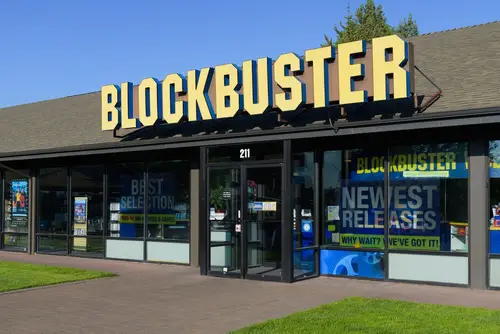
No Friday night was complete without a trip to Blockbuster. The chain’s blue-and-yellow sign was a beacon for movie lovers until streaming and Redbox crushed its business. Most stores were gone by 2014, except for the famous “last Blockbuster” in Bend, Oregon. For fans, old membership cards and VHS tapes with Blockbuster stickers are fun reminders of the past.
Some collectors are even snapping up uniforms, rental cases, and branded popcorn tubs. These items are now sold as retro memorabilia, with nostalgia driving their value. People love the physical connection to movie nights of the ’90s and early 2000s. It’s a reminder of when choosing a movie meant pacing aisles, not scrolling menus.
2. Circuit City
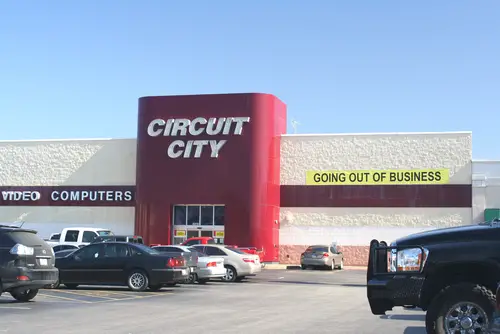
Before Best Buy and Amazon dominated electronics, Circuit City was where families went for TVs, VCRs, and the latest gadgets. The retailer folded in 2009, leaving behind shuttered stores and millions of branded products in living rooms across America. Old Circuit City receipts and catalogs have become nostalgic keepsakes for tech lovers. Some vintage electronics with Circuit City labels now fetch surprising prices online.
The real treasures are the quirky house-brand electronics the store once sold. Its “Civic” line of televisions and stereos often pop up at estate sales. Collectors say these devices capture a transitional era in home entertainment. Owning one is like holding a piece of retail history.
3. Toys “R” Us
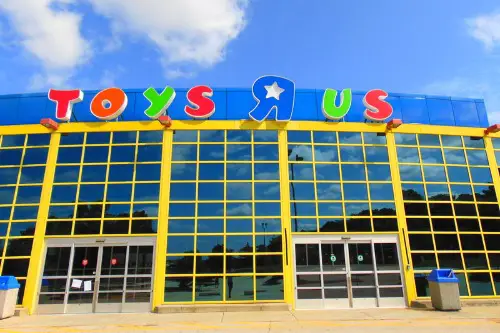
For decades, Toys “R” Us was the ultimate wonderland for kids. It closed most of its U.S. stores in 2018 after years of financial trouble. Parents who once shopped there now hold onto toys, bags, and even Geoffrey the Giraffe plushies with extra care. Some of these toys have become collector’s items, especially exclusive store editions.
The store’s exclusive Barbie dolls and LEGO sets often sell for much more than their original price. Shoppers also seek out branded gift cards, which remain a quirky collectible even though they no longer hold value. Geoffrey merchandise is particularly hot among fans of ’80s and ’90s toy culture. Nostalgia has turned these souvenirs into tiny time capsules.
4. Woolworth’s
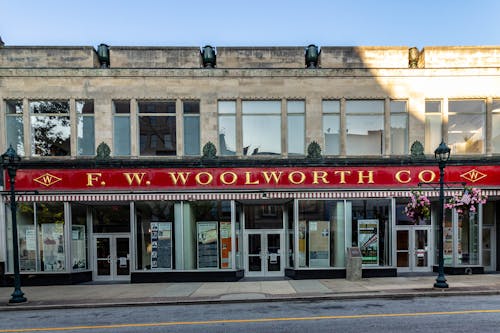
Once called the “Five-and-Dime,” Woolworth’s was a cornerstone of U.S. shopping for over a century. By the late ’90s, it couldn’t compete with big-box stores and officially closed in 1997. Many families still remember sitting at its lunch counters or picking up school supplies. Today, vintage Woolworth’s lunch counter menus, dishes, and signage are prized antiques.
Collectors love the soda fountain stools and branded china once used in stores. Even Woolworth’s toy merchandise, sold under its house brands, has value. These items are more than retail leftovers—they’re pieces of American social history. For some, owning them is like stepping back into simpler times.
5. KB Toys
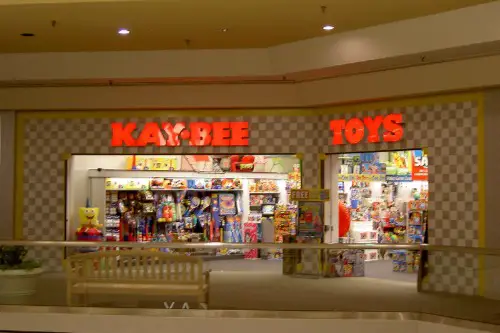
Mall trips in the ’80s and ’90s often meant a stop at KB Toys. Known for its discount bins and bright red logo, the chain closed in 2009. Many of the toys it sold, from action figures to board games, now carry collectible appeal. Some items still come in packaging with the KB price sticker proudly displayed.
That sticker alone can increase the value, because it ties the toy to its retail origin. Shoppers often hunt for toys from KB-exclusive promotions. Even unused shopping bags are bought and sold by nostalgic fans. It’s a reminder of when malls were thriving community hangouts.
6. Linens ’n Things
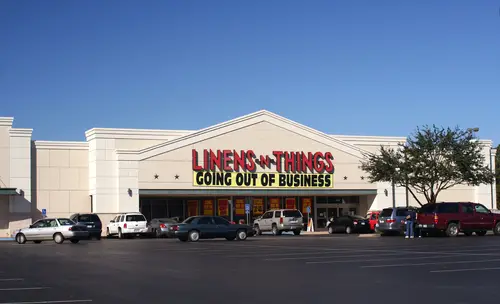
Linens ’n Things was once Bed Bath & Beyond’s biggest rival. The home goods store went bankrupt in 2008, though its name has popped up online since. What remains valuable are the discontinued product lines it carried, especially high-quality bedding and cookware. Shoppers who still own items from its premium lines find they last for decades.
Collectors specifically search for the brand’s collaboration items, like exclusive kitchenware. Some people also hunt down unopened store stock on resale sites. Even branded shopping bags and signage occasionally appear for sale. These items highlight a time when home stores were booming before e-commerce took over.
7. Sharper Image
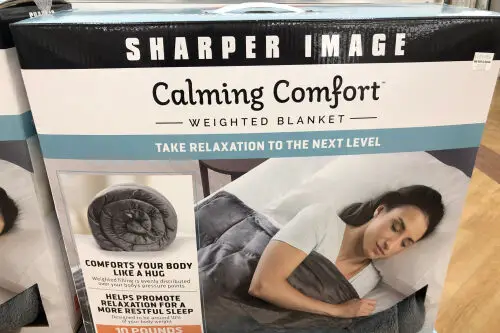
Sharper Image was the go-to place for futuristic gadgets and “as seen on TV” curiosities. The stores shut down in 2008, though the brand still exists in limited form online. People remember its quirky products like air purifiers, massage chairs, and alarm clocks that projected the time on ceilings. Many of those original gadgets are collectible today.
The Ionic Breeze air purifier, once the store’s signature product, is a particularly sought-after conversation piece. Original catalogs and product packaging also have a niche resale market. Fans of retro tech see Sharper Image gear as both kitschy and forward-looking. Having one of its gadgets today feels like owning a slice of the early 2000s.
8. Borders
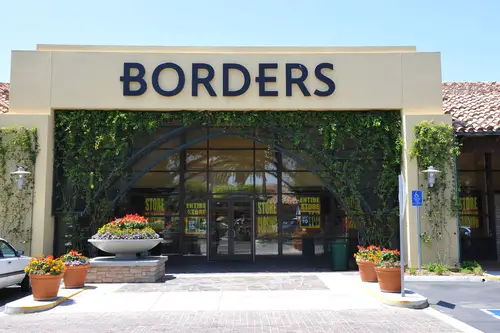
Before e-books took over, Borders was a beloved bookstore chain. It closed its last U.S. stores in 2011 after struggling against Amazon and Barnes & Noble. Many former customers still own Borders-branded bookmarks, coffee mugs, and tote bags. These small items have become sentimental keepsakes for avid readers.
First-edition books sold exclusively at Borders can fetch good money today. Some collectors look for Borders’ in-house music and DVD compilations, which were once staples near checkout counters. Even store fixtures like bookshelves and café signs occasionally pop up for sale. It’s a reminder of when bookstores felt like community gathering spots.
9. Pan American World Airways (Pan Am)
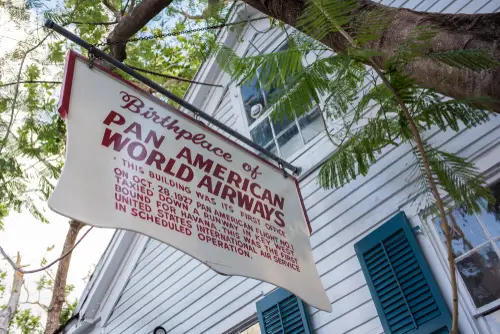
Though not a retail store, Pan Am was one of the most iconic U.S. airlines. It went bankrupt in 1991, but its brand left behind a treasure trove of collectibles. Flight bags, uniforms, and branded glassware remain in high demand. Even safety cards and ticket stubs can be valuable.
Pan Am’s distinctive blue globe logo has turned its merchandise into design icons. Collectors often prize items tied to the glamorous era of jet travel in the ’60s and ’70s. Original stewardess uniforms are especially sought-after. Owning a Pan Am item feels like tapping into the golden age of aviation.
10. RadioShack

RadioShack was a haven for hobbyists and anyone needing batteries, cables, or niche electronic parts. Its retail presence collapsed after 2015, though a small online version lingers. People who bought house-brand gadgets like Realistic radios or Tandy computers still hold onto them. Some of these items are now highly collectible.
Vintage computers sold at RadioShack are especially valuable among tech fans. Even branded tools and component drawers carry nostalgic appeal. Manuals and original store signage are also collected as part of hobbyist culture. It’s a reminder of when tinkering with electronics was a mainstream pastime.
11. Montgomery Ward

For over a century, Montgomery Ward was a major department store. It closed its stores in 2001 after losing ground to modern retailers. Wards catalogs were once household staples, and many still survive as collectibles. These catalogs serve as both retail memorabilia and cultural snapshots.
People also prize branded housewares and appliances sold under the Wards name. Old sewing machines, refrigerators, and radios often sell well on the vintage market. Even store signage and promotional materials hold nostalgic value. Collectors see them as representing a lost era of American retail.
12. Tower Records

For music lovers, Tower Records was more than a store—it was a cultural hub. The U.S. chain went bankrupt in 2006, though its brand still operates in Japan. Old Tower shopping bags, t-shirts, and posters are widely collected. Music fans love them for their connection to the golden age of record shopping.
Exclusive vinyl pressings sold at Tower are some of the most valuable leftovers. Concert tickets and in-store promotional items also carry appeal. For many, Tower represents a time when discovering music meant digging through aisles, not streaming playlists. Holding onto a Tower item feels like preserving music history.
13. Compaq
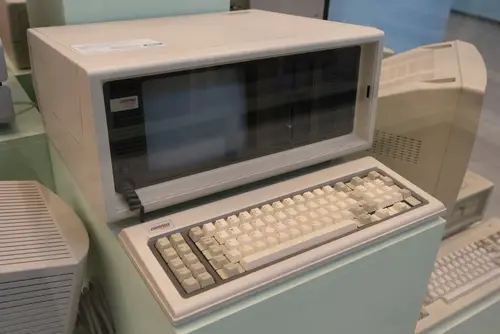
Compaq was once a leader in personal computers, rivaling IBM in the 1980s and ’90s. The brand disappeared after HP acquired it in 2002. Collectors now value its laptops and desktops, particularly early portable models. These computers are iconic for their role in making PCs more accessible.
Early Compaq “luggables,” which were suitcase-sized portable computers, are especially collectible. Branded accessories like manuals and floppy disks also sell online. Computer historians view these machines as landmarks of the personal computing boom. Owning one today feels like touching the roots of modern tech.
14. Pier 1 Imports

Pier 1 was famous for quirky home décor and global-inspired furniture. It closed its U.S. stores in 2020 after filing for bankruptcy. Many of its imported ceramics, textiles, and rattan furniture are now valued by collectors. Shoppers love the unique, bohemian vibe of Pier 1 pieces.
Limited-edition seasonal items, especially holiday décor, are especially collectible. Even branded bags and signage sometimes sell to nostalgic shoppers. These items embody a specific era of home design in the U.S. Owning one can be both stylish and nostalgic.
15. Sears

Once the king of American retail, Sears defined shopping for generations. After years of decline, its stores largely vanished by the late 2010s. People still hold onto Sears Craftsman tools, Kenmore appliances, and DieHard car batteries. These items are often prized for their durability and brand legacy.
Collectors also value old Sears catalogs, which once shaped consumer culture nationwide. Vintage appliances with Sears branding often fetch high prices. Even promotional merchandise like store signage has a secondary market. Sears may be gone, but its products live on in garages, kitchens, and collections across the country.
This post 15 Household Brands That Vanished—But Left Behind Valuable Items was first published on Greenhouse Black.
